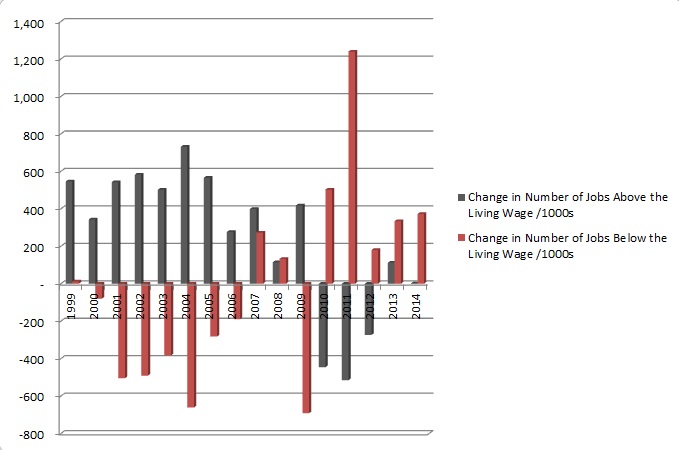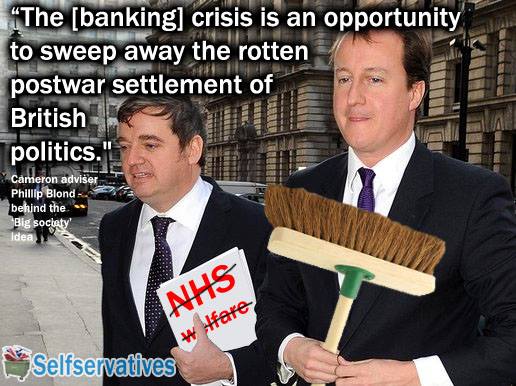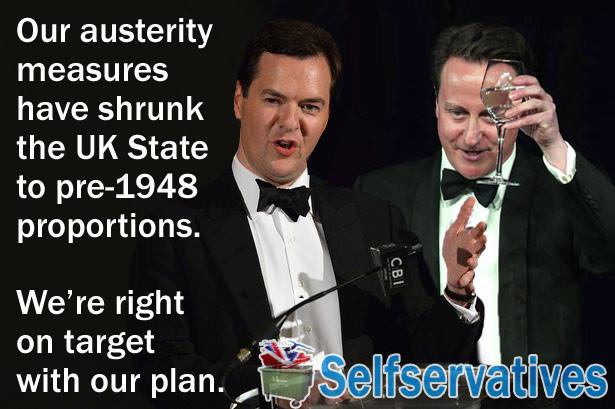
The Conservatives’ summer budget saw a new national minimum wage set. However, it has been re-branded as a “national living wage” as the Conservatives claim that it should be what people need to live on. Employers will no longer be allowed to pay the £6.70-an-hour rate, but will have to pay the new “national living wage” of £7.20 an hour to people over the age of 25. Call me a cynic, but the psychosemantic re-branding of a minimum wage increase of less than a pound an hour is a diversion because the government intend to stop subsidising low wages through tax credits.
Increasing the minimum wage is simply not adequate to reduce poverty. Forty per cent of individuals earning between the minimum wage and the actual amount that would be the Living Wage campaigners want, are in households in the top half of the income distribution. They aren’t poor. Tax credits on the other hand are much more highly targeted at those in need of support. Whilst the public understand what the minimum wage was about, renaming this new policy the “National Living Wage” will inevitably create confusion, as many will incorrectly assume that the government are targeting the same rate as that advocated by the Living Wage campaign – a figure based on estimates in line with the cost of living. They aren’t.
The Living Wage Foundation say:
- The current UK Living Wage ought to be £8.25 an hour
- The current London Living Wage ought to be £9.40 an hour
However, the Resolution Foundation have issued a press release that says the Prime Minister should allow the in-built flexibility of the “national living wage” to “take its course.”
Conor D’Arcy, Policy Analyst at the Resolution Foundation, said: “Some businesses are unhappy about a higher minimum wage, particularly amid the post-referendum uncertainty. But backsliding on the government commitment is unnecessary given the in-built flexibility of the policy to adjust to changing economic circumstances. It would also be costly for millions of low paid workers, so the Prime Minister should stick to her guns.”
Backsliding on the so-called “National Living Wage” (NLW) could leave some full-time workers up to £1,000 a year worse off by 2020 – with women, the young and older workers most likely to lose out – according to the new analysis published yesterday (Wednesday) by the Resolution Foundation.
Earlier this year, the introduction of the NLW delivered an average 7.5 per cent pay rise to around 4.5 million workers aged 25 and over. Low-paid workers are set for another four years of above average pay rises as it approaches its target ‘bite’ of being worth 60 per cent of typical hourly pay by 2020.
More recently, May has put tackling squeezed living standards at the centre of her new government. However, some business organisations have called on the government to water down its plans following the EU referendum. In a letter to the Business Secretary Greg Clark, 16 trade associations called on government to “exercise caution” in light of “the economic uncertainties the country faces”.
Such calls are understandable given the challenge of a higher wage floor for some businesses. However the Foundation says that the in-built flexibility of the NLW – which automatically adjusts to economic shifts by being pegged to typical hourly pay, rather than the £9 cash figure that many people associate the policy with – means that there is no need to water down the policy.
The Foundation’s analysis, based on the latest summary of independent economic forecasts published by the Treasury, shows that the NLW is currently on track to rise to around £8.70 in 2020. That’s lower than the £9 forecast in the March 2016 Budget, due to expectations of weaker wage growth. The Foundation notes that the projected figure for 2020 is likely to rise and fall in coming years as wage forecasts are updated and the actual impact of implementing Brexit becomes clear.
The Foundation says the Prime Minister should therefore stick to her guns and press on with implementing a policy that will deliver a pay rise for six million workers – and support her vision for an economy that works for everyone, not just the privileged few.
Torsten Bell, Director of the Resolution Foundation, said:
“Theresa May is right to stick to her guns on the National Living Wage. Britain has a serious low pay problem and now of all times is not the moment to put off dealing with it.”
The Foundation adds that sticking to the current policy is very different to pursuing a cash target of £9 or higher in the face of weaker overall wage growth. That approach, which some advocate, could jeopardise the success of the NLW.
Ahead of a crucial meeting of the Low Pay Commission in October to decide their recommendation for next April’s NLW rate, the analysis shows that should the government scale back its ambition over the next four years – for example by raising the NLW at a similar pace to the recent minimum wage increases applied after the 2008 financial crisis – its value would fall by around 55p per hour in 2020. This would lower the annual pay of a full-time worker on the NLW by around £1,000, relative to current plans. Should the current ‘bite’ of the NLW be maintained, rather than increased to 60 per cent by 2020, the annual pay would be reduced by £1,500.
Around one in five women and one in five workers aged 26-30 would lose out from any backsliding on the National Living Wage, as would over a quarter of workers aged 66 and over.
The Foundation says that the main focus for the government should now be on implementation. To do this, it is calling for the government’s upcoming industrial strategy and productivity plan to include a focus on the often unheralded low-paying sectors of the economy, and not just on areas like digital and high-value manufacturing. This will help employers handle the higher labour costs brought about by the NLW.
The analysis is part of the Foundation’s upcoming report Low Pay Britain 2016, which will be published later this month.
Conor D’Arcy, Policy Analyst at the Resolution Foundation, said:
“The National Living Wage is a hugely popular policy that is set to deliver a pay rise to six million of Britain’s lowest paid workers and play a pivotal role in the Prime Minister’s vision for an economy that works for everyone, not just the privileged few.
“Understandably some businesses are unhappy about a higher minimum wage, particularly amid the post-referendum uncertainty. But backsliding on the government commitment is unnecessary given the in-built flexibility of the policy to adjust to changing economic circumstances. It would also be costly for millions of low paid workers, so the Prime Minister should stick to her guns.
“The government’s attention should instead turn to the huge task of implementation. This should ensuring that its upcoming industrial strategy includes the less glamorous but hugely important sectors like retail and hospitality, which are at the coalface of Britain’s huge low pay challenge.”
Review recommendations
- While the National Living Wage is a welcome boost to low earners, the Living Wage with its genuine link to an acceptable cost of living, remains as vital as ever.
- But as we have made clear, improvements are possible in both methods and seeking alignment will inevitably lead to change. We believe the recommendations we have outlined in this review represent a genuine improvement over the current methods. The aligned method should be more representative, more robust and, most importantly, driven to a greater extent by changes in the cost of living.
- Inevitably, calculating a Living Wage requires judgement calls. Policy changes like the introduction of Universal Credit would always have required judgements on how the new system is phased into the rate. Having a body like the Living Wage Commission to make such decisions when required in future can only be an asset to the Living Wage campaign as it moves forward.
- The natural question which follows these recommendations is what impact is likely on the rates themselves. However, the next steps are for the Living Wage Commission to consider our recommendations. The options they choose will determine the extent to which the rates vary from their current levels.
- Broadly speaking however, the aligned method we have recommended is likely to have an upward effect on the London Living Wage. We consider this to be an unavoidable consequence of a Living Wage rooted in an up-to-date basket of goods with a more diverse mix of family types. There is a clear discrepancy in the target income between London and the rest of the UK, and as highlighted by recent analysis on the size of London salary weightings[1] the differential between rates should be larger than at present. The exact size of the increase will depend on the Living Wage Commission and Mayor’s response to our review. They also have a role in setting out a how to implement and transition to the new rates in London and the rest of the UK.
- The Living Wage Commission is expected to respond to our review in September 2016. With a strong, aligned methodology and an enhanced governance structure, we see no reason why the Living Wage cannot continue to raise the wages of workers across the UK, delivering more families an acceptable standard of living.
Notes
- The ‘bite’ of the National Living Wage – its value relative to typical hourly pay – is set to increase by 4.3 percentage points over the next four years. The ‘bite’ of the National Minimum Wage (NMW) increased 1.7 percentage points in the four years following the financial crisis. Should the NLW instead follow this path, rather than the one currently set out, its value in 2020 would fall to £8.17 an hour. That’s 55p an hour less than the latest economic forecasts imply, equivalent to £1,075 to a full-time worker on the NLW.
- The Resolution Foundation forecasts that by 2020 around 12 per cent of workers will be earning the National Living Wage, including 19 per cent of women, 19 per cent of 26-30 year olds and 26 per cent of workers aged 66+.
I don’t make any money from my work. But you can help me keep going by making a donation so I can continue to research, to write free, informative, insightful and independent articles, and to provide support to others. The smallest amount is much appreciated – thank you.




